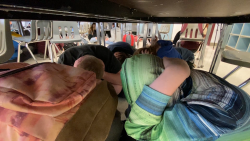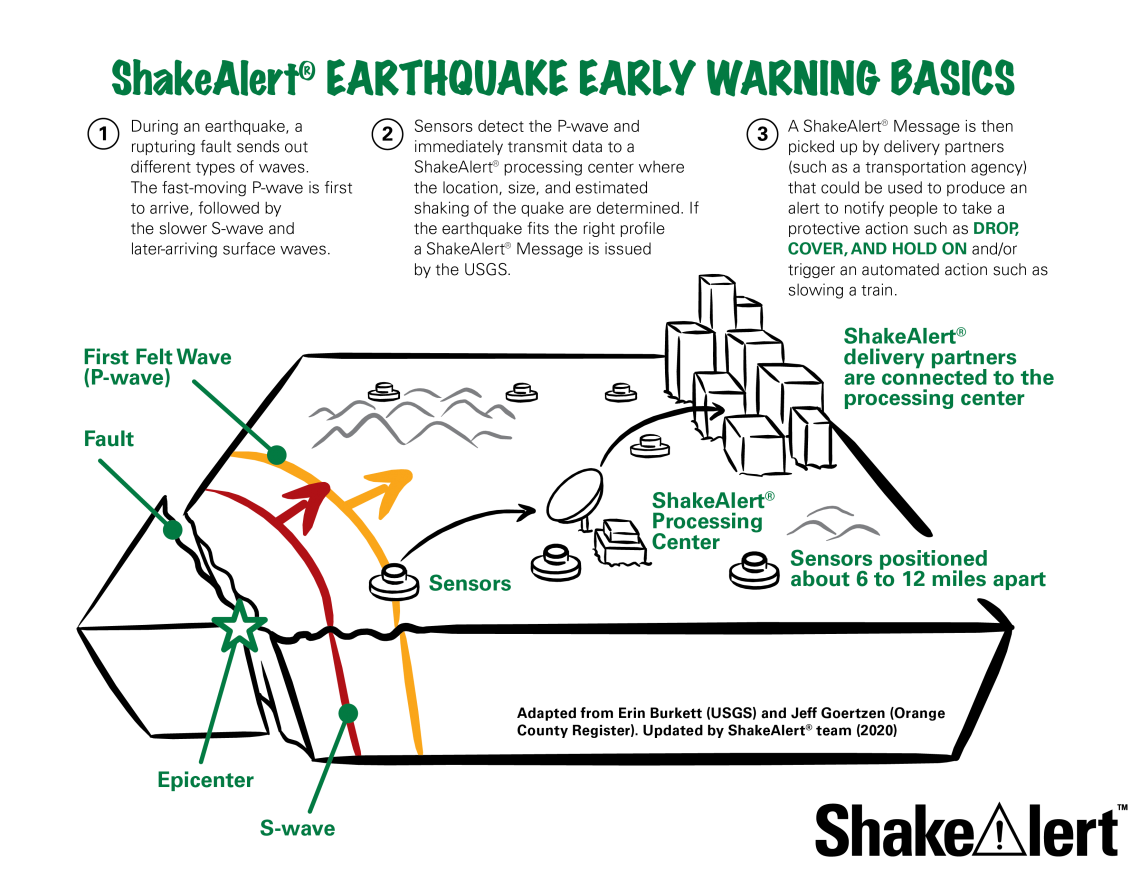On October 21, thousands of students, teachers and staff in the Stanwood Camano School District and beyond “Dropped, Covered and Held On” at exactly 10:21 a.m., emulating the synchronicity of a well-rehearsed dive team. The Great ShakeOut Earthquake Drill, held around the globe annually and supported locally by the University of Washington’s Pacific Northwest Seismic Network (PNSN), is a coordinated effort to practice what to do in the event of an actual earthquake.
“As far as human behaviors go, if you don’t practice protecting yourself when an earthquake strikes, people tend to freeze up or run,” said PNSN director of communications and outreach Bill Steele. “We need to develop muscle memory of actually practicing to stop, drop and hold on. By doing this, when actual shaking starts hopefully that action will become instinctual. It’s good to keep building upon the muscle memory annually, and the Great ShakeOut provides the perfect opportunity to practice.”
Growing in reach since its inception in 2006, the event is now the biggest earthquake exercise of the year and hopes to train behavior to minimize stress and confusion in the event of an earthquake.
ShakeAlert in schools

The PNSN helped introduce the Stanwood Camano School District to contractors who connected schools to the ShakeAlert Earthquake Early Warning system. The project was spearheaded by Dale-Ann Baker, a Stanwood Elementary parent volunteer and PTA activist. Baker learned about the developing ShakeAlert System during a UW Seismology Lab tour for fourth grade classes, and was inspired to inform district staff and teachers about the system. Baker then helped gain the unanimous support of the Board of Education to invest in a computer interface which processes the ShakeAlert message in the event of an earthquake greater than magnitude 4.5 and pushes it out an audio alert through the building PA system.
In a typical installation, the physical ShakeAlert-powered computer box sits on the wall, connects to the internet and plugs into a PA system. This equipment and installation are relatively inexpensive, and the Stanwood Camano School District has just expanded its implementation from one to 13 school PA systems receiving alerts. This year’s drill included a test of the expanded system. “We hope this will inspire other school districts to implement ShakeAlert,” said Steele.
Stanwood Elementary houses the ShakeAlert sensor, which acts as a hub for the 13 schools and support buildings in the district. On the day of the ShakeOut event, school administrators pushed a button on the ShakeAlert box, manually triggering the verbal warning to drop, cover and hold on. This was the first year the Great ShakeOut drill was combined with the ShakeAlert warning system across the school district, which added a tactical tool to the toolbox of school safety mechanisms.
“Earthquake drills and ShakeAlert are perfect complements — using the earthquake early warning PA alert to launch the drill gets kids used to the alarm itself and what to do next. This is a tremendous, low cost way to increase the safety of kids in Washington state,” said PNSN director and UW Earth and Space Sciences professor Harold Tobin.
Stanwood Camano School District superintendent Deborah Rumbaugh emphasized the importance of having access to the ShakeAlert system throughout the district. Rumbaugh notes that “school districts have a special role to play in earthquake readiness because our community’s children are in our care for seven hours or more each day. This is another tool that helps us meet the challenge of providing a safe learning environment for our students and staff.”
Alerts are just the start
ShakeAlert is just one piece of the disaster preparedness puzzle in terms of services that PNSN offers. “We also want to urge schools to start thinking of non-structural hazard mitigation,” said ShakeAlert user engagement facilitator Gabriel Lotto. “In the event of an earthquake, are all the cabinets securely fastened to the walls so they won’t fall down and hit anyone? What about furniture, computers, ceiling tiles or HVAC systems? These are all things that have the ability to seriously injure students and staff in the event of an earthquake, and should be considered when preparing for safety.”
The structure of the building itself is also important. On June 30, 2021, the Department of Natural Resources released the School Seismic Safety Project (SSSP) 2019-2021 Legislative Report, which summarized the earthquake risk at 561 school buildings (274 schools at 245 campuses) across the state. Districts with known problem buildings were included in this study, which found that 93% of the buildings studied were vulnerable to collapse in an earthquake.
Looking ahead, PNSN is working to connect more schools in Washington to contractors who will install ShakeAlert-powered alerting systems, with a focus on coastal communities facing tsunami risk as well as setting up devices in highly urbanized areas. “We want to see ShakeAlert Earthquake Early Warning become a normal part of life in Washington,” said Lotto. “Every building has a fire alarm. Here in earthquake country, earthquake alerts should be just as common.”
About PNSN
To monitor earthquake and volcanic activity across the Pacific Northwest, the University of Washington and the University of Oregon cooperatively operate the Pacific Northwest Seismic Network (PNSN). Beginning in 1969 with five seismometers, the PNSN has grown to more than 300 seismograph stations distributed across the region and become the second largest seismic network in the United States.
The PNSN seeks to reduce risk within the states of Washington and Oregon by:
- Monitoring ground motions within the region in order to better understand earthquake and volcano hazards and their impacts on the physical, economic, political and social environment
- Providing the most accurate information about earthquakes and volcanoes as rapidly as possible to public officials, the public and for education
- Advocating comprehensive and cost-effective measures for reducing the harmful effects of earthquakes and volcanoes
The PNSN is sponsored by the U.S. Geological Survey (USGS), the U.S. Department of Energy, the State of Washington and the State of Oregon.
How does ShakeAlert work?
ShakeAlert uses data collected from hundreds of seismometers in the region to generate alerts and ground motion predictions, may of which were installed and are maintained by UW’s PNSN.The PNSN data center at UW processes earthquake data from hundreds of instruments in near-real time. With partners at the University of Oregon, University of California Berkeley, CalTech and the USGS, UW scientists process ShakeAlert messages and continuously work to improve this vital Earthquake Early Warning System. The USGS then “publishes” that data, which is instantly accessible to the ShakeAlert licensed boxes programmed to take automated actions such as closing valves, cutting power to vulnerable machinery and alerting people to get in a safe place to “Drop, Cover and Hold On.” All of this happens in a few seconds, allowing most people to take cover before the actual shaking arrives at their location.


